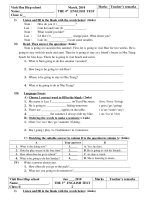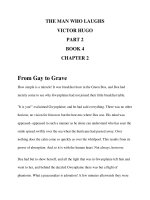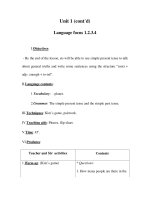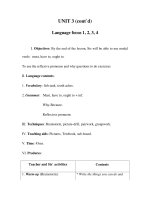4 1 2 the long trip west
Bạn đang xem bản rút gọn của tài liệu. Xem và tải ngay bản đầy đủ của tài liệu tại đây (2.07 MB, 10 trang )
Suggested levels for Guided Reading, DRA,™
Lexile,® and Reading Recovery™ are provided
in the Pearson Scott Foresman Leveling Guide.
The Long
Trip West
by Joseph Blaire
Genre
Expository
nonfiction
Comprehension
Skills and Strategy
• Author’s Purpose
• Main Idea and
Details
• Answer Questions
Text Features
• Maps
• Captions
• Glossary
Scott Foresman Reading Street 4.1.2
ISBN 0-328-13415-5
ì<(sk$m)=bdebfb< +^-Ä-U-Ä-U
illustrated by Tom McNeely
Reader Response
The Long
Trip West
1. Why did the author write about the Louisiana
Purchase and the Corps of Discovery?
2. What was Sacagawea able to do for Lewis and
Clark? Where in the text did you look to find the
answer?
3. Make a chart similar to the one below. List scents
you think belong in each category.
Scents in My Life
Scents on Lewis
and Clark’s Trip
4. How did the map on page 15 help you understand
where the Corps of Discovery traveled?
by Joseph Blaire
illustrated by Tom McNeely
Editorial Offices: Glenview, Illinois • Parsippany, New Jersey • New York, New York
Sales Offices: Needham, Massachusetts • Duluth, Georgia • Glenview, Illinois
Coppell, Texas • Ontario, California • Mesa, Arizona
In 1803 Thomas Jefferson was president of the
United States. At that time the United States was
smaller than it is today. Much of the land west of
the Mississippi River had been owned by Spain.
But in 1800, Spain had given the land to France.
Jefferson wanted to buy the land from France.
President Thomas Jefferson
Every effort has been made to secure permission and provide appropriate credit for
photographic material. The publisher deeply regrets any omission and pledges to
correct errors called to its attention in subsequent editions.
Unless otherwise acknowledged, all photographs are the property of Scott Foresman,
a division of Pearson Education.
Illustrations by Tom McNeely
ISBN: 0-328-13415-5
Copyright © Pearson Education, Inc.
All Rights Reserved. Printed in the United States of America. This publication is
protected by Copyright, and permission should be obtained from the publisher
prior to any prohibited reproduction, storage in a retrieval system, or transmission
in any form by any means, electronic, mechanical, photocopying, recording, or
likewise. For information regarding permission(s), write to: Permissions Department,
Scott Foresman, 1900 East Lake Avenue, Glenview, Illinois 60025.
2 3 4 5 6 7 8 9 10 V0G1 14 13 12 11 10 09 08 07 06 05
3
On April 30, 1803, the leader of France agreed
to sell this land to the United States. The deal was
called the Louisiana Purchase. It doubled the size
of the United States.
Jefferson knew that Americans would begin
migrating, or moving. They would move from
east to west into the land the country got in the
Louisiana Purchase. This new territory, or area,
spanned west from the Mississippi River to the
Rocky Mountains. It spanned south from British
North America to the Gulf of Mexico.
British North America
Oregon
Country
Indiana
Territory
Rocky
Mountains
Missouri River
UNITED STATES
LOUISIANA PURCHASE
Pacific
Ocean
Mississippi River
N
United States and
territories around 1803
W
E
S
4
Gulf of
Mexico
5
In 1803 President Jefferson also created the
Corps of Discovery. The Corps of Discovery was a
team led by Meriwether Lewis and William Clark.
The team’s job was to find and write about the
rivers, mountains, animals, and Native American
nations of the American West. The team’s goal
was to reach the Pacific Ocean.
The Rocky Mountains lie to the west.
6
Lewis and Clark, more than forty-five other
people, and Lewis’s black Newfoundland dog
named Seaman became the Corps of Discovery.
President Jefferson gave them the money they
needed for their trip.
The Corps of Discovery loads trip supplies.
7
On May 14, 1804, the Corps of Discovery left
the wharf of Camp Dubois in what is now Illinois.
They began the long trip westward on the
Missouri River. The trip was difficult. Some of the
men became ill. It was also very hot. Clark made
many maps. Lewis studied plants and animals.
He took notes and made simple drawings of his
discoveries.
The Corps of Discovery sets sail toward
the west on the Missouri River.
8
The group met many Native Americans. Lewis
and Clark needed to be able to talk and trade
with the Native Americans. A woman named
Sacagawea helped them. She was part of the
Native American Shoshone nation. She translated.
She also helped the group find plants to eat. She
knew the land and helped guide the trip.
Sacagawea translates for Lewis and Clark.
9
On May 26, 1805, Lewis scanned the horizon.
He saw the Rocky Mountains for the first
time. They were rugged and tall. The Corps of
Discovery traded with Sacagawea’s Shoshone and
with another Native American nation, the Salish.
They got horses to ride through the mountains.
Meriwether Lewis sees the Rocky Mountains.
10
The trip over the steep mountains was tough.
The weather was very cold. It was hard to find
food. Many of the men were starving.
The team travels through the mountains.
11
But the Corps of Discovery kept going. They
made it over the mountains. Now they had to
cross rivers. They left the horses behind and
made canoes. The Corps of Discovery yearned
to see the Pacific Ocean. In November 1805 the
Corps of Discovery finally reached the ocean.
The Corps travels in canoes toward the Pacific.
12
The scent of saltwater filled the air. The men
decided to rest. They built Fort Clatsop near the
coast in what is now Oregon. They stayed there
through the cold, wet winter. Lewis and Clark
worked on their maps and scientific records of
plants and animals. Then on March 23, 1806, the
Corps of Discovery began the trip back home.
The Corps of Discovery sets up camp.
13
They reached the docks of St. Louis on
September 23, 1806. It was close to where they
had started about 2 1–2 years before. They had
traveled nearly eight thousand miles across
America! They had mapped rivers and created
scientific journals. They had been introduced to
many Native American cultures. And they had
proved that travel across the continent to the
Pacific Ocean was possible.
The United Sates is a richer nation because of
the Louisiana Purchase and men like Meriwether
Lewis and William Clark. President Thomas
Jefferson also achieved his goal of exploring the
American West. These early Americans helped
to make the United States of America what it is
today.
Fort Clatsop
The trip west
The trip back home
St. Louis
LOUISIANA PURCHASE
The journey of the Corps of Discovery
comes to an end in St. Louis, Missouri.
Pacific
Ocean
Trail of the trip
Gulf of
Mexico
14
15
Glossary
docks n. platforms built
on the shore or out
from the shore; wharfs;
piers.
migrating v. moving
from one region to
another.
scanned v. glanced at;
looked over hastily.
scent n. a smell.
Reader Response
translated v. changed
from one language into
another.
wharf n. a platform
built on the shore or out
from the shore, beside
which ships can load
and unload.
yearned v. felt a
longing or desire;
desired earnestly.
1. Why did the author write about the Louisiana
Purchase and the Corps of Discovery?
2. What was Sacagawea able to do for Lewis and
Clark? Where in the text did you look to find the
answer?
3. Make a chart similar to the one below. List scents
you think belong in each category.
Scents in My Life
Scents on Lewis
and Clark’s Trip
4. How did the map on page 15 help you understand
where the Corps of Discovery traveled?
16









